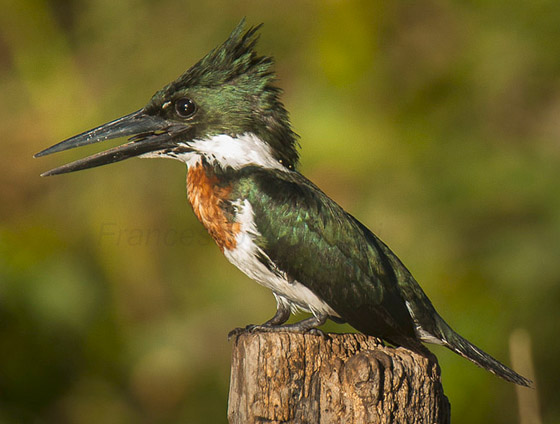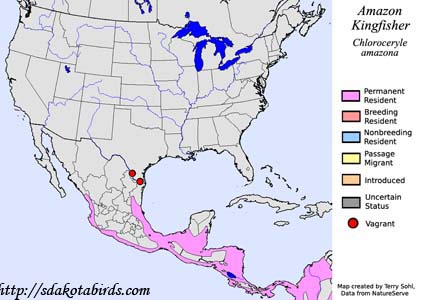| Length: 11 inches | Wingspan: 20 inches | Seasonality: Non-resident in South Dakota |
| ID Keys: Bronzy-green overall, white throat/collar, white underneath, rufous breast (male), green breast (female) | ||
 The
Amazon Kingfisher is normally found from Argentina northward into southern
and central Mexico. In the United States, it is only known from a
handful of sightings, with the first occurring in 2010 in Laredo, Texas.
In range they are very similar in overall plumage to the Green Kingfisher,
but the Amazon Kingfisher is much larger in size. Amazon Kingfishers
tend to use large waterways and are not as often found on smaller or more
rugged waterways as are Green Kingfishers.
The
Amazon Kingfisher is normally found from Argentina northward into southern
and central Mexico. In the United States, it is only known from a
handful of sightings, with the first occurring in 2010 in Laredo, Texas.
In range they are very similar in overall plumage to the Green Kingfisher,
but the Amazon Kingfisher is much larger in size. Amazon Kingfishers
tend to use large waterways and are not as often found on smaller or more
rugged waterways as are Green Kingfishers.
Habitat: Prefers broad, open water bodies and rivers, primarily in lowlands. In most of its range it is found on large, slow-moving rivers, while its smaller relative the Green Kingfisher is the one more often found on faster, smaller waters.
Diet: Feeds heavily on fish if available. They will also feed on crustaceans, amphibians and insects.
Behavior: Foraging is often done by observing from a high perch, then plunge-diving after prey once it is spotted. They are also capable of hovering and plunge-diving from a hovering position. They are typically solitary, except during the breeding season.
Nesting: Breeds in burrows built into the side of a river bank, with the burrows up to 6 feet in depth. Both the male and the female will help construct the nesting burrow. The female lays between 3 and 5 eggs, and both parents will help to incubate them. After hatching, both parents help to raise the young.
Migration: Considered a permanent resident throughout its normal range.
Song: Has a series of harsh rattles and 'kreck" calls that carry for some distance.
Similar species: Similar in appearance to the Green Kingfisher but is much larger in size.
Interactive eBird Map: Click here to access an interactive eBird map of Amazon Kingfisher sightings
Conservation Status: Populations appear to be stable and they are found across a very wide geographic area. The IUCN lists the Amazon Kingfisher as a species of "Least Concern".
Further Information: 1) Beauty of Birds - Amazon Kingfisher
2) BirdLife International - Amazon Kingfisher
3) Cornell's Neotropical Birds - Amazon Kingfisher
Photo Information: Photo taken by Francesco Veronesi - Photo licensed under Creative Commons Attribution NonCommercial ShareAlike 2.0 Generic License.
| Click below for a higher-resolution map |
 |
| South Dakota Status: Non-resident in South Dakota |
Additional Amazon Kingfisher Photos (coming soon!!)
